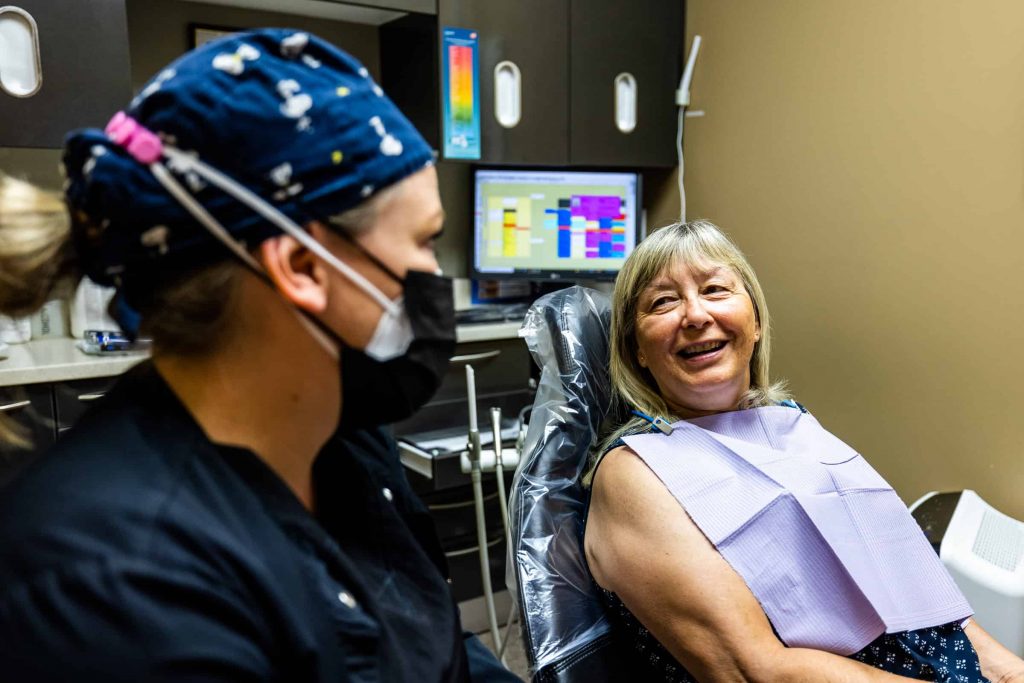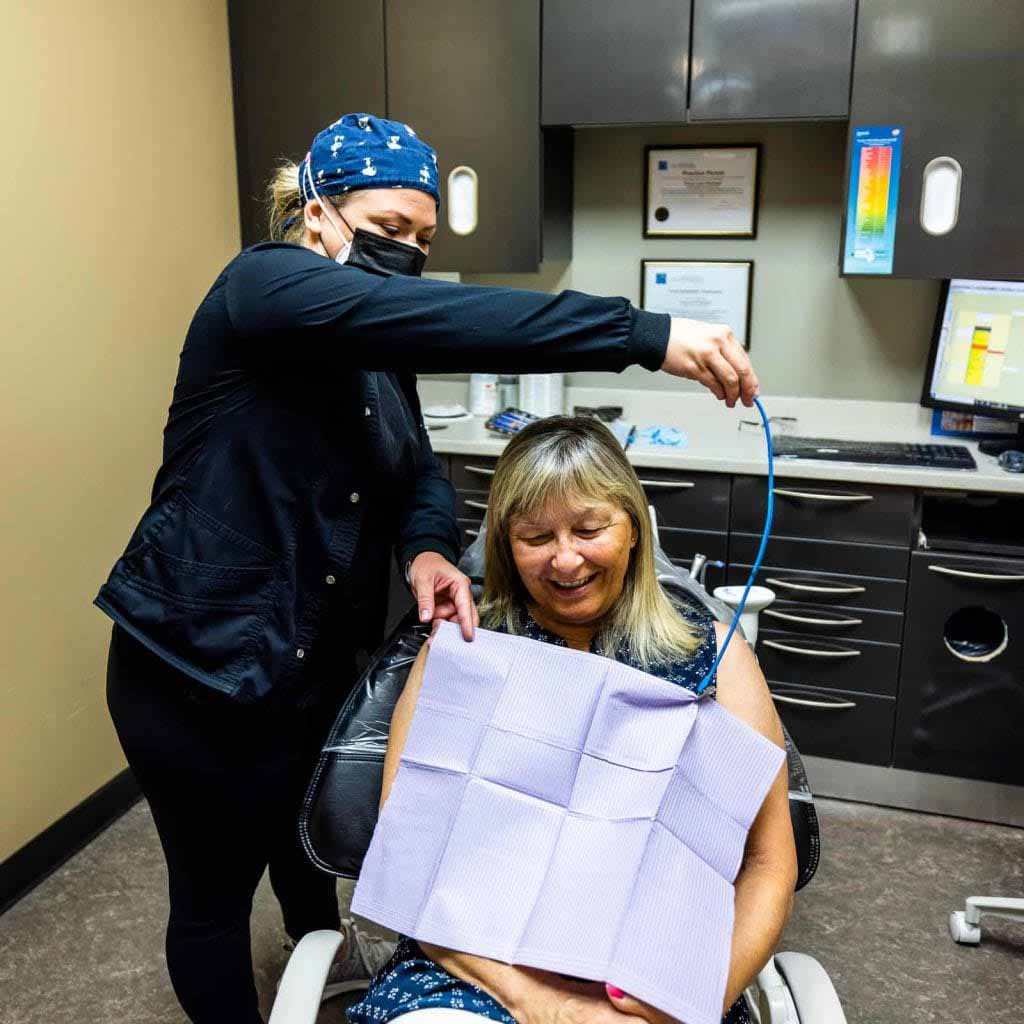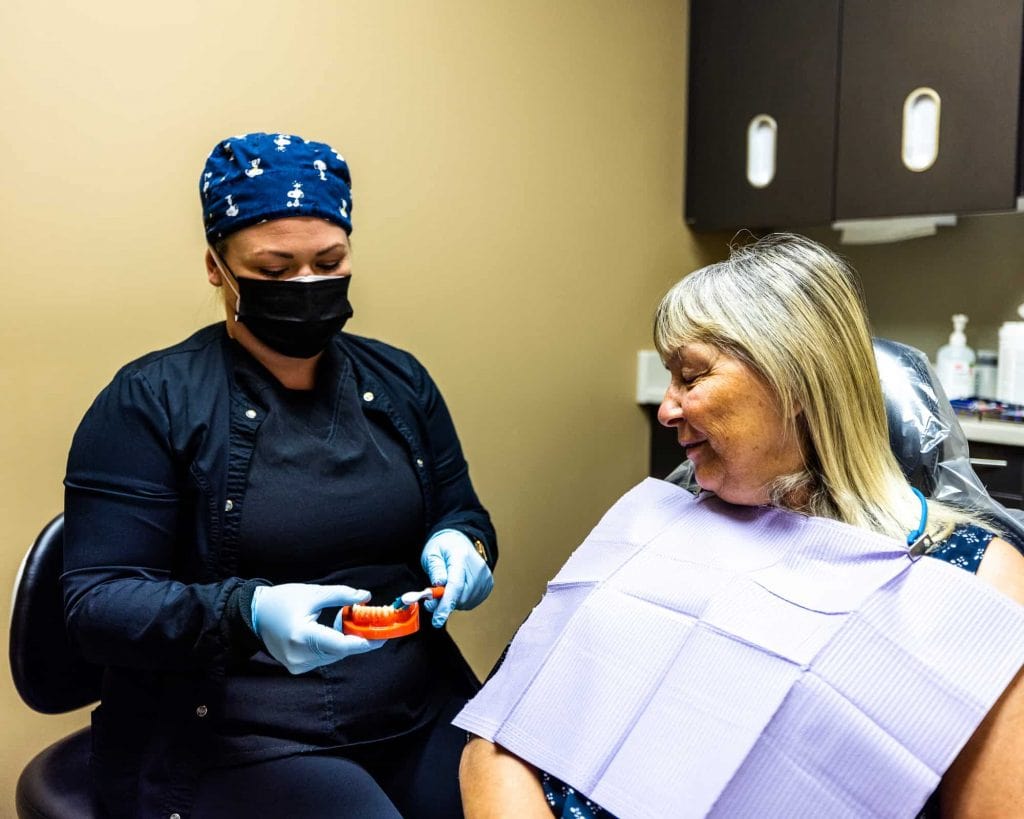What is Periodontal Disease?
The word periodontal means “around the tooth”. Periodontal disease attacks the gums and the bone that support the teeth. Plaque is a sticky film of food debris, bacteria, and saliva. If plaque is not removed, it turns into calculus (tartar). When plaque and calculus are not removed, they begin to destroy the gums and bone. Periodontal disease is characterized by red, swollen, and bleeding gums.
Four out of five people have periodontal disease and don’t know it! Most people are not aware of it because the disease is usually painless in the early stages.
Not only is it the number one reason for tooth loss, research suggests that there may be a link between periodontal disease and other diseases such as, stroke, bacterial pneumonia, diabetes, cardiovascular disease, and increased risk during pregnancy. Researchers are determining if inflammation and bacteria associated with periodontal disease affects these systemic diseases and conditions. Smoking also increases the risk of periodontal disease.
Good oral hygiene, a balanced diet, and regular dental visits can help reduce your risk of developing periodontal disease.

Signs & Symptoms of Periodontal Disease:
- Bleeding gums – Gums should never bleed, even when you brush vigorously or use dental floss.
- Loose teeth – Also caused by bone loss or weakened periodontal fibers (fibers that support the tooth to the bone).
- Tenderness or Discomfort – Plaque, calculus, and bacteria irritate the gums and teeth.
- Receding gums – Loss of gum around a tooth.
- New spacing between teeth – Caused by bone loss.
- Pus around the teeth and gums – Sign that there is an infection present.
- Red and puffy gums – Gums should never be red or swollen.
- Persistent bad breath – Caused by bacteria in the mouth.
Schedule Your Consultation Today!
What is Periodontics?
The term “periodontics” refers to the dental specialty that pertains to the prevention, diagnosis and treatment of periodontal disease that affects the gums and jawbone. The gum tissues serve to surround and support the teeth and the underlying jawbone anchors teeth firmly in place. Periodontists have completed several years of extra dental training and are concerned with maintaining the function, health and aesthetics of the jawbone and tissues.

Reasons for Periodontal Treatment
Periodontal disease is a progressive condition which begins with mild gum inflammation called gingivitis. It is the leading cause of tooth loss in adults living in the developed world, and should be taken very seriously. Periodontal disease (often called gum disease) is typically signified by red, swollen, painful, or bleeding gums, but in some cases has no noticeable symptoms.
Periodontal disease generally begins when the bacteria living in plaque cause an infection in the surrounding tissues of the teeth, causing them to become irritated and painful. Eventually, this infection will cause the jawbone to recede and the tooth to become loose.
There are several reasons why periodontal treatment may be necessary:
Moderate/advanced gum disease – This occurs when the gums are bleeding, swollen or red around most teeth and the jawbone has begun to recede.
Localized gum recession – The infection which propagates moderate or advanced gum disease often begins in one area. Gum recession may also be caused due to over brushing with a hard bristle brush, or due to a tooth that is not positioned properly. Immediate treatment is required to prevent further spreading.
Before crown lengthening – The periodontist may lengthen the crown of the tooth by removing surrounding soft tissue to provide more tooth exposure.
Ridge augmentation – This procedure, often called “recontouring” may be required to correct an uneven gum line. Before embarking on treatment, a periodontist needs to treat any bacterial infections and periodontitis.
How to treat mild/moderate periodontal problems?

In the case of mild/moderate periodontal problems, the focus of the periodontist will be on curing the underlying bacterial infection and then providing advice on the most appropriate home cleaning methods.
Sometimes a deep scaling is needed to remove the bacterial plaque and calculus (tartar) from the teeth and tissues. Where periodontal disease is advanced and the jawbone has regressed significantly, more intensive cleaning may be recommended and loose teeth that cannot be saved will be removed.
The periodontist is trained in all aspects of dental implant procedures, which can restore functionality to the mouth when teeth have been affected by periodontitis.
Because periodontal disease is progressive, it is essential to remove the bacteria and calculus build-up to halt the spread of the infection. Your dentist will be happy to advise you on effective cleaning methods and treatment options.
Schedule Your Consultation Today!
What is a Periodontist?
A periodontist is a dentist who specializes in the soft tissues of the mouth and the underlying jawbone which supports the teeth. A dentist must first graduate from an accredited dental school before undertaking an additional three years of study within a periodontology residency training program, in order to qualify as a periodontist.
The primary focus of this residency training is on both surgical and non surgical management of periodontal disease and the placement of dental implants.

Conditions Treated By A Periodontist
The periodontist is mainly concerned with: preventing the onset of gum disease (periodontal disease); diagnosing conditions affecting the gums and jawbone; and treating gingivitis, periodontitis, and bone loss. Periodontal disease is a progressive condition and the leading cause of tooth loss among adults in the developed world.
The periodontist is able to treat mild, moderate and advanced gum disease by first addressing the bacterial infection at the root of the problem, providing periodontal treatment, then providing information and education on good oral hygiene and the effective cleaning of the teeth.
The most common conditions treated by a periodontist are:
Gingivitis – This is the mild inflammation of the gums which may or may not be signified by pain and bleeding.
Mild/moderate periodontitis – When the pockets between the teeth and the soft tissues are measured to be between 4-6mm it is classified as moderate periodontitis (gum disease).
Advanced periodontitis – When the pockets between the teeth and the soft tissues in general exceed 6mm in depth, significant bone loss may occur; causing shifting or loss of teeth.
Missing teeth – When teeth are missing as a result of bone loss, the periodontist can implant prosthetic teeth. These teeth are anchored to the jawbone and restore functionality to the mouth.
Schedule Your Consultation Today!
Ask Us Anything
If you experience any of these signs and symptoms, it is important that you schedule an appointment with a periodontist without delay:
Bleeding while eating or brushing – Unexplained bleeding while consuming food or during the course of daily cleaning is one of the most common signs of periodontal infection.
Bad breath – Continued halitosis (bad breath) which persists even when a rigorous oral hygiene program is in place, can be indicative of periodontitis, gingivitis, or the beginnings of an infection in the gum tissues.
Loose teeth and gum recession – Longer-looking teeth can signal recession of the gums and bone loss due to periodontal disease. As this disease progresses and attacks the jawbone, (the anchor holding the teeth in place) the teeth may become loose or be lost altogether.
Gangrene in the tissues – Gangrene is hard to self-diagnose but the general dentist and periodontist will check for its presence in the soft tissues, alveolar bone, and periodontal ligament.
Related health conditions – Heart disease, diabetes, osteopenia, and osteoporosis are highly correlated with periodontitis and periodontal infections. The bacteria infection can spread through the bloodstream and affect other parts of the body.
The periodontist is able to perform a wide range of treatments to halt the progression of gum disease, replace missing teeth and make the appearance of the smile more aesthetically pleasing.
Here are some of the treatments commonly performed by the periodontist:
Implant placement – When a tooth or several teeth are missing, the periodontist is able to create a natural-looking replacement by anchoring a prosthetic tooth to the jawbone.
Osteoplasty (hard tissue recontouring) – Once periodontitis has been treated, the periodontist can recontour the hard tissue to make the smile both natural-looking and aesthetically pleasing.
Gingivoplasty (soft tissue recontouring) – As gums recede due to periodontitis, the teeth may appear longer; causing a “toothy” smile. The periodontist can remove tissues or straighten the gum line to make the teeth look more even.
Bone grafting – Dental implants can only be positioned if there is sufficient bone to attach the prosthetic tooth to. If bone loss has occurred, bone grafting is an excellent way to add or “grow” bone so that an implant may be properly secured.
Deep pocket cleanings – As gingivitis and periodontitis progress, it becomes more difficult to cleanse the pockets between the soft tissues and the teeth. The periodontist can scale and root plane the teeth (sometimes under local anesthetic) to remove debris and infection-causing bacteria.
Crown lengthening – In order to expose more of the natural tooth, the periodontist can remove some of the surrounding gingival tissue.
The periodontist is a highly skilled dental health professional who is able to diagnose and treat many commonly occurring soft tissue and bone problems in the oral cavity.
Before initiating any dental treatment, the periodontist must extensively examine the gums, jawbone and general condition of the teeth. When gingivitis or periodontal disease is officially diagnosed, the periodontist has a number of surgical and non surgical options available to treat the underlying infection, halt the recession of the soft tissue, and restructure or replace teeth which may be missing.
Gingivitis/mild periodontal disease – When the gum pockets exceed 4mm in depth, the periodontist or hygienist may perform scaling and root planing to remove debris from the pockets and allow them to heal. Education and advice will be provided on an effective cleaning regime thereafter.
Moderate periodontal disease – If the gum pockets reach 4-6mm in length, a more extensive scaling and root planing cleaning might be required. This cleaning is usually performed under local anesthetic.
Advanced periodontal disease – Gum pockets in excess of 6-7mm are usually accompanied by bone loss and gum recession. Scaling and root planing will always be performed as the initial nonsurgical treatment. In addition to tose nonsurgical treatments, the periodontist may recommend surgical treatment to reduce pocket depth.
Tooth loss – Where one or several teeth are missing due to periodontal disease, dental implants are an effective option. If the bone is strong enough to provide a suitable anchor for the prosthetic tooth, the implant can be placed. However, if the bone is severely eroded, bone grafts may be performed by the periodontist to provide a suitable anchor for the new tooth/teeth.
Here at Quarry Park dental, we make sure that you understand exactly how much you’re going to pay for your dental treatment that’s why we’ve created a pricing page to help you learn more about your dental fees.
